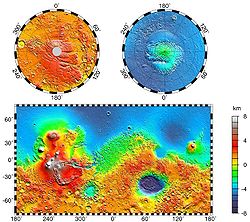
Vastitas Borealis
Encyclopedia

Mars
Mars is the fourth planet from the Sun in the Solar System. The planet is named after the Roman god of war, Mars. It is often described as the "Red Planet", as the iron oxide prevalent on its surface gives it a reddish appearance...
. It is in the northerly latitudes of the planet
Planet
A planet is a celestial body orbiting a star or stellar remnant that is massive enough to be rounded by its own gravity, is not massive enough to cause thermonuclear fusion, and has cleared its neighbouring region of planetesimals.The term planet is ancient, with ties to history, science,...
and encircles the northern polar region. Vastitas Borealis is often simply referred to as the Northern plains or Northern lowlands of Mars. The plains lie 4–5 km below the mean radius of the planet. To the north lies Planum Boreum
Planum Boreum
Planum Boreum is the northern polar plain on Mars. It extends northward from roughly 80°N and is centered at . Surrounding the high polar plain is a flat and featureless lowland plain called Vastitas Borealis which extends for approximately 1500 kilometres southwards, dominating the northern...
.
The region was named by Eugene Antoniadi, who noted the distinct albedo feature
Albedo feature
An albedo feature is a large area on the surface of a planet which shows a contrast in brightness or darkness with adjacent areas....
of the Northern plains in his book La Planète Mars (1930). The name was officially adopted by the International Astronomical Union
International Astronomical Union
The International Astronomical Union IAU is a collection of professional astronomers, at the Ph.D. level and beyond, active in professional research and education in astronomy...
in 1973.
Two distinct basins are recognized within the Vastitas Borealis: the North Polar Basin
North Polar Basin (Mars)
The North Polar Basin, or Borealis basin, is a large basin in the northern hemisphere of Mars that covers 40% of the planet. Chryse Planitia, the landing site of the Viking 1 lander, is a bay which opens into this basin....
and Utopia Planitia
Utopia Planitia
Utopia Planitia is the largest recognized impact basin on Mars with an estimated diameter of 3300 km, and is the Martian region where the Viking 2 lander touched down and began exploring on September 3, 1976. It is located at the antipode of Argyre Planitia, centered at...
. Some scientists have speculated the plains were covered by an ocean
Ocean
An ocean is a major body of saline water, and a principal component of the hydrosphere. Approximately 71% of the Earth's surface is covered by ocean, a continuous body of water that is customarily divided into several principal oceans and smaller seas.More than half of this area is over 3,000...
at some point in Mars' history and putative shorelines have been suggested for its southern edges. Today these mildly sloping plains are marked by ridges, low hills, and sparse cratering. Vastitas Borealis is noticeably smoother than similar topographical areas in the south.
In 2005 the European Space Agency
European Space Agency
The European Space Agency , established in 1975, is an intergovernmental organisation dedicated to the exploration of space, currently with 18 member states...
's Mars Express
Mars Express
Mars Express is a space exploration mission being conducted by the European Space Agency . The Mars Express mission is exploring the planet Mars, and is the first planetary mission attempted by the agency. "Express" originally referred to the speed and efficiency with which the spacecraft was...
spacecraft imaged a substantial quantity of water ice in a crater in the Vastitas Borealis region. The environmental conditions at the locality of this feature are suitable for water ice to remain stable. It was revealed after overlaying frozen carbon dioxide sublimated away at the commencement of the Northern Hemisphere Summer and is believed to be stable throughout the Martian year.

NASA
The National Aeronautics and Space Administration is the agency of the United States government that is responsible for the nation's civilian space program and for aeronautics and aerospace research...
probe named Phoenix
Phoenix (spacecraft)
Phoenix was a robotic spacecraft on a space exploration mission on Mars under the Mars Scout Program. The Phoenix lander descended on Mars on May 25, 2008...
landed safely in a region of Vastitas Borealis unofficially named Green Valley
Green Valley (Mars)
Green Valley is a region on Mars within Vastitas Borealis that was chosen as the landing site of NASA's Phoenix lander. It is located at 68.35 degrees north, 233 degrees east. The valley is about 50 kilometres wide but only about 250 metres deep; either it was filled in or was never any deeper than...
on May 25, 2008 (in the early Martian summer). Phoenix landed at 68.218830°N 234.250778°E. The probe, which will remain stationary, collected and analyzed soil samples in an effort to detect water and determine how hospitable the planet might once have been for life to grow. It remained active there until winter conditions became too harsh around five months later.
External links
- Martel, L.M.V. (July, 2003) Ancient Floodwaters and Seas on Mars. Planetary Science Research Discoveries. http://www.psrd.hawaii.edu/July03/MartianSea.html

